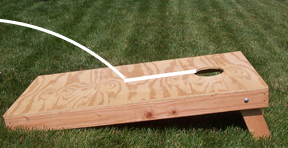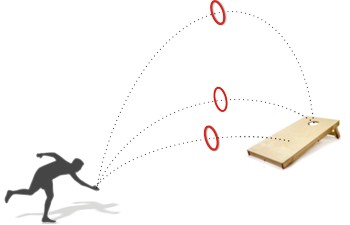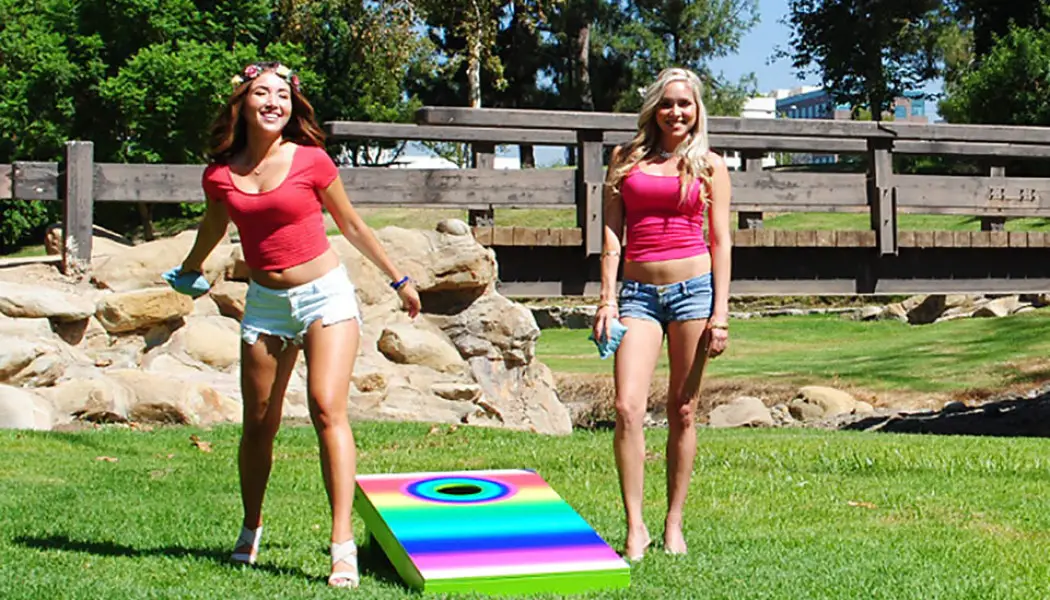There are a number of vital elements to be considered when tossing a cornhole bag effectively. The difference between the pros and the casuals is largely due to the mechanisms of a proper toss and how effective these techniques can be repeated.
You may also like: How to make Cornhole Bags in less than 1 Hour
An effective and repeatable toss, however, is certainly more of an art than a science.
The following are some tips you may want to follow when tossing a cornhole bag:

First Tip: “Slide” the Bag Into the Hole
Effectively utilizing the board slides will help earn you more cornholes as it gives you a larger target to aim for, especially with your initial tosses (before other bags are on the board).
If you are lucky enough, you will get boards that are very slick. However, there are times you will be forced to use boards on which the bags just “stick.” In such a case, adjusting your arc will be the best alternative to use. I highly recommend taking some practice tosses before the game begins so you can get a feel for how much the bag is going to slide when tossed, especially at different angles.
Consider the demonstration below that lets you utilize slide for your own benefit. What are your odds of throwing the bag right into the 6 inch hole? (hint: much lower than sliding it in)
To get more cornholes, sliding will be a vital technique to master. As you aim to get more cornholes with via sliding, remember to toss it straight and use proper form when doing so.
In addition to tossing a cornhole, sliding can also be used to push away your opponents bags when they are in the scoring zone.

Second Tip: Spin the Bag Into the Hole
The difference between the pros and the casuals is most apparent when it comes to spinning the bag. Most pros are known to use a variety of spin tosses. The bag becomes more stable when combined with a spin and it also helps increase control and can effectively withstand windy conditions.
The most common spin type is a “hook.” This can be accomplished by turning your hand inwards as you bring your arm forward and then releasing the bag with a slight twisting of your fingers. As opposed to bowling where your entire hand is involved in creating the “hooking” spin, good cornhole spin technique revolves around the usage of the fingers to provide most of the spin.
It’s going to take a bit of practice to get used to it but once you master this technique, you’ll never go back to your old knucke-ball form. More advanced cornholers can even spin the bag with a “slicing” or “screwball” type rotation that will allow for increasing maneuvering of the bag once it hits the board. This can be extremely effective depending upon the placement of your opponents bags on the board.
Again, practice makes perfect with this tip.

Third Tip: Experiment with Various Arc Angles
The recommended arc for the bag flight is in the range of 6ft to 9ft. You risk losing accuracy if you use any higher and the bag will have a tendency to bounce off the board.
On the flip side, if the arc is kept lower, chances are the bag will slide off the board as it is likely to be carrying a lot of speed as it hits the board. As you begin to have a grasp of the toss, place your attention on the target foregoing the bag’s flight. To ensure that bounce is lowered, strive to have your bags landing at a slight angle as compared to flat. The impact is decreased in such a scenario and your bags remain stuck on the boards much better.
I like to use the mental image of the famous carnival/mid-way game where you “win” if you can toss a ball into a large bucket and get it to stay without bouncing out. It looks very simple but is nearly impossible to master as it completely depends on the perfect combination of arc, spin and speed to get the ball to stay. Think about this imagery as you work on experimenting with different angles (and spin also!).

Fourth Tip: Utilize Proper Form and Strive for Consistency
To keep your bags flying straight, it is vitally important to have the right form. There is no one perfect way to toss a bag but a few key principles need to be followed if you are going to have long-term success.
- Prepare and Visualize: this involves blocking-out distractions and focusing on your target. I recommend taking at least 2 large steps back from your anticipated “tossing” location so that you can step into the toss without incurring a penalty. Try to emulate a bowling professional who has just picked up the ball from the rack and is getting prepared for the roll.
- Step Into the Throw: again this will largely depend upon experimentation but advanced cornholers typically take 1-2 steps before their toss. There are even some that take no steps at all. Feel free to experiment with different combinations of steps and find out what allows you to throw the straightest and, most importantly, can be repeated exactly the same every time! I can’t emphasize this enough, the key to being successful at tossing the bag is finding out what technique works best for you and is something you can repeat every single time, without variation!
- Follow-Thru: This is a bit less critical but some find it very important as it allows for more consistent pacing after your throw. As you can tell I like giving you visual images and in this case I’d think of a bowler or golfer who has just completed their motion and is watching the outcome of their efforts. Developing a consistent follow-through helps to reduce variation in your routing and will lead to more consistent tosses.
And finally…Relax!

As with any sport, once you’ve played enough times, the main obstacle to winning is all in your head. After all, you’re just throwing a bag at a board.
Frequently Asked Questions
What is the regulation size of a cornhole bag?
The regulation size of the cornhole bag is 6 square inches with an inward stitched seam. The finished weight of the bag must be 14-16 ounces. You can fill your bags with feed corn kernels or resin pellets.
What are the different throw styles for cornhole?
Sling Toss: It is an underarm throw style and results in a backspin. You can achieve a sling toss throw by pinching the bag in the corner with your thumb and index finger, spin your arm backward and throw the bag at the board with an underarm throw.
Frisbee Throw: This throw style is similar to Frisbee throwing. You hold the bag like you would hold a Frisbee, turn your body sideways, and then swing your arm while aiming the board/hole. It is a complex style but gets very fruitful once you get a hold of it.
Overhand Throw: Overhand throwing style resembles pitching a baseball. You use overhand or sidearm movement in this style.
Jump Toss: This throwing style is like throwing a basketball. You’ll need to hold the bag in one hand and line up the shot and the aim with the other hand. Jump toss style has a scoring probability of 50%. Either you get three, or you get 0.
Fold-Over Throw: A fold-over throw is achieved by folding the bag in halves like a newspaper or a piece of clothing and then throwing it underarm.
Which bag gets a better throw, corn-filled or pellet-filled?
Corn-filled and pellet-filled bags have no difference in regards to throw. This is a big misconception that corn-filled bags get a better spin. We frequently play with both bags and have never noticed any difference as far as the throw is concerned. The only difference is that corn-filled bags slide into the hole more often than pellet-filled bags because corn breaks down after some throws and leaves corn dust on the board. It helps slide the bag over the board.
